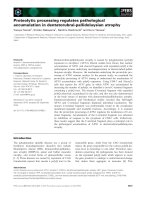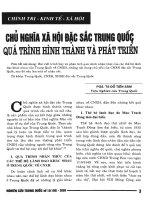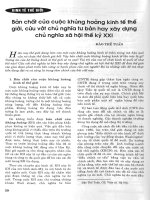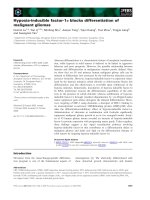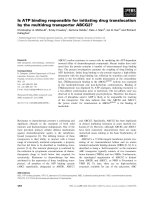Tài liệu Báo cáo khoa học: "Adaptive String Distance Measures for Bilingual Dialect Lexicon Induction" pdf
Bạn đang xem bản rút gọn của tài liệu. Xem và tải ngay bản đầy đủ của tài liệu tại đây (117.92 KB, 6 trang )
Proceedings of the ACL 2007 Student Research Workshop, pages 55–60,
Prague, June 2007.
c
2007 Association for Computational Linguistics
Adaptive String Distance Measures
for Bilingual Dialect Lexicon Induction
Yves Scherrer
Language Technology Laboratory (LATL)
University of Geneva
1211 Geneva 4, Switzerland
Abstract
This paper compares different measures of
graphemic similarity applied to the task
of bilingual lexicon induction between a
Swiss German dialect and Standard Ger-
man. The measures have been adapted
to this particular language pair by training
stochastic transducers with the Expectation-
Maximisation algorithm or by using hand-
made transduction rules. These adaptive
metrics show up to 11% F-measure improve-
ment over a static metric like Levenshtein
distance.
1 Introduction
Building lexical resources is a very important step in
the development of any natural language processing
system. However, it is a time-consuming and repeti-
tive task, which makes research on automatic induc-
tion of lexicons particularly appealing. In this pa-
per, we will discuss different ways of finding lexical
mappings for a translation lexicon between a Swiss
German dialect and Standard German. The choice
of this language pair has important consequences on
the methodology. On the one hand, given the so-
ciolinguistic conditions of dialect use (diglossia), it
is difficult to find written data of high quality; par-
allel corpora are virtually non-existent. These data
constraints place our work in the context of scarce-
resource language processing. On the other hand,
as the two languages are closely related, the lexical
relations to be induced are less complex. We argue
that this point alleviates the restrictions imposed by
the scarcity of the resources. In particular, we claim
that if two languages are close, even if one of them is
scarcely documented, we can successfully use tech-
niques that require training.
Finding lexical mappings amounts to finding
word pairs that are maximally similar, with respect
to a particular definition of similarity. Similarity
measures can be based on any level of linguistic
analysis: semantic similarity relies on context vec-
tors (Rapp, 1999), while syntactic similarity is based
on the alignment of parallel corpora (Brown et al.,
1993). Our work is based on the assumption that
phonetic (or rather graphemic, as we use written
data) similarity measures are the most appropriate
in the given language context because they require
less sophisticated training data than semantic or syn-
tactic similarity models. However, phonetic simi-
larity measures can only be used for cognate lan-
guage pairs, i.e. language pairs that can be traced
back to a common historical origin and that possess
highly similar linguistic (in particular, phonologi-
cal and morphological) characteristics. Moreover,
we can only expect phonetic similarity measures to
induce cognate word pairs, i.e. word pairs whose
forms and significations are similar, as a result of a
historical relationship.
We will present different models of phonetic sim-
ilarity that are adapted to the given language pair. In
particular, attention has been paid to develop tech-
niques requiring little manually annotated data.
2 Related Work
Our work is inspired by Mann and Yarowsky
(2001). They induce translation lexicons between
a resource-rich language (typically English) and a
scarce resource language of another language fam-
ily (for example, Portuguese) by using a resource-
55
rich bridge language of the same family (for ex-
ample, Spanish). While they rely on existing
translation lexicons for the source-to-bridge step
(English-Spanish), they use string distance models
(called cognate models) for the bridge-to-target step
(Spanish-Portuguese). Mann and Yarowsky (2001)
distinguish between static metrics, which are suffi-
ciently general to be applied to any language pair,
and adaptive metrics, which are adapted to a spe-
cific language pair. The latter allow for much finer-
grained results, but require more work for the adap-
tation. Mann and Yarowsky (2001) use variants of
Levenshtein distance as a static metric, and a Hidden
Markov Model (HMM) and a stochastic transducer
trained with the Expectation-Maximisation (EM) al-
gorithm as adaptive metrics. We will also use Leven-
shtein distance as well as the stochastic transducer,
but not the HMM, which performed worst in Mann
and Yarowsky’s study.
The originality of their approach is that they ap-
ply models used for speech processing to cognate
word pair induction. In particular, they refer to a
previous study by Ristad and Yianilos (1998). Ris-
tad and Yianilos showed how a stochastic transducer
can be trained in a non-supervised manner using the
EM algorithm and successfully applied their model
to the problem of pronunciation recognition (sound-
to-letter conversion). Jansche (2003) reviews their
work in some detail, correcting thereby some errors
in the presentation of the algorithms.
Heeringa et al. (2006) present several modifica-
tions of the Levenshtein distance that approximate
linguistic intuitions better. These models are pre-
sented in the framework of dialectometry, i.e. they
provide numerical measures for the classification of
dialects. However, some of their models can be
adapted to be used in a lexicon induction task. Kon-
drak and Sherif (2006) use phonetic similarity mod-
els for cognate word identification.
Other studies deal with lexicon induction for cog-
nate language pairs and for scarce resource lan-
guages. Rapp (1999) extends an existing bilin-
gual lexicon with the help of non-parallel cor-
pora, assuming that corresponding words share co-
occurrence patterns. His method has been used by
Hwa et al. (2006) to induce a dictionary between
Modern Standard Arabic and the Levantine Arabic
dialect. Although this work involves two closely re-
lated language varieties, graphemic similarity mea-
sures are not used at all. Nevertheless, Schafer and
Yarowsky (2002) have shown that these two tech-
niques can be combined efficiently. They use Rapp’s
co-occurrence vectors in combination with Mann
and Yarowsky’s EM-trained transducer.
3 Two-Stage Models of Lexical Induction
Following the standard statistical machine transla-
tion architecture, we represent the lexicon induction
task as a two-stage model. In the first stage, we use
the source word to generate a fixed number of can-
didate translation strings, according to a transducer
which represents a particular similarity measure. In
the second stage, these candidate strings are filtered
through a lexicon of the target language. Candidates
that are not words of the target language are thus
eliminated.
This article is, like previous work, mostly con-
cerned with the comparison of different similarity
measures. However, we extend previous work by
introducing two original measures (3.3 and 3.4) and
by embedding the measures into the proposed two-
stage framework of lexicon induction.
3.1 Levenshtein Distance
One of the simplest string distance measures is the
Levenshtein distance. According to it, the distance
between two words is defined as the least-cost se-
quence of edit and identity operations. All edit oper-
ations (insertion of one character, substitution of one
character by another, and deletion of one character)
have a fixed cost of 1. The identity operation (keep-
ing one character from the source word in the target
word) has a fixed cost of 0. Levenshtein distance op-
erates on single letters without taking into account
contextual features. It can thus be implemented in
a memoryless (one-state) transducer. This distance
measure is static – it remains the same for all lan-
guage pairs. We will use Levenshtein distance as a
baseline for our experiments.
3.2 Stochastic Transducers Trained with EM
The algorithm presented by Ristad and Yianilos
(1998) enables one to train a memoryless stochastic
transducer with the Expectation-Maximisation (EM)
algorithm. In a stochastic transducer, all transitions
represent probabilities (rather than costs or weights).
56
The transduction probability of a given word pair is
the sum of the probabilities of all paths that gen-
erate it. The goal of using the EM algorithm is to
find the transition probabilities of a stochastic trans-
ducer which maximise the likelihood of generating
the word pairs given in the training stage. This
goal is achieved iteratively by using a training lex-
icon consisting of correct word pairs. The initial
transducer contains uniform probabilities. It is used
to transduce the word pairs of the training lexicon,
thereby counting all transitions used in this process.
Then, the transition probabilities of the transducer
are reestimated according to the frequency of usage
of the transitions counted before. This new trans-
ducer is then used in the next iteration.
This adaptive model is likely to perform better
than the static Levenshtein model. For example, to
transduce Swiss German dialects to Standard Ger-
man, inserting n or e is much more likely than in-
serting m or i. Language-independent models can-
not predict such specific facts, but stochastic trans-
ducers learn them easily. However, these improve-
ments come at a cost: a training bilingual lexicon of
sufficient size must be available. For scarce resource
languages, such lexicons often need to be built man-
ually.
3.3 Training without a Bilingual Corpus
In order to further reduce the data requirements,
we developed another strategy that avoided using a
training bilingual lexicon altogether and used other
resources for the training step instead. The main
idea is to use a simple list of dialect words, and the
Standard German lexicon. In doing this, we assume
that the structure of the lexicon informs us about
which transitions are most frequent. For example,
the dialect word chue ‘cow’ does not appear in the
Standard German lexicon, but similar words like
Kuh ‘cow’, Schuh ‘shoe’, Schule ‘school’, Sache
‘thing’, Kühe ‘cows’ do. Just by inspecting these
most similar existing words, we can conclude that c
may transform to k (Kuh, Kühe), that s is likely to
be inserted (Schuh, Schule, Sache), and that e may
transform to h (Kuh, Schuh). But we also conclude
that none of the letters c, h, u, e is likely to transform
to ö or f, just because such words do not exist in
the target lexicon. While such statements are coinci-
dental for one single word, they may be sufficiently
reliable when induced over a large corpus.
In this model, we use an iterative training algo-
rithm alternating two tasks. The first task is to build
a list of hypothesized word pairs by using the di-
alect word list, the Standard German lexicon, and a
transducer
1
: for each dialect word, candidate strings
are generated, filtered by the lexicon, and the best
candidate is selected. The second task is to train a
stochastic transducer with EM, as explained above,
on the previously constructed list of word pairs. In
the next iteration, this new transducer is used in the
first task to obtain a more accurate list of word pairs,
which in turn allows us to build a new transducer
in the second task. This process is iterated several
times to gradually eliminate erroneous word pairs.
The most crucial step is the selection of the best
candidate from the list returned by the lexicon filter.
We could simply use the word which obtained the
highest transduction probability. However, prelimi-
nary experiments have shown that the iterative algo-
rithm tends to prefer deletion operations, so that it
will converge to generating single-letter words only
(which turn out to be present in our lexicon). To
avoid this scenario, the length of the suggested can-
didate words must be taken into account. We there-
fore simply selected the longest candidate word.
2
3.4 A Rule-based Model
This last model does not use learning algorithms.
It consists of a simple set of transformation rules
that are known to be important for the chosen lan-
guage pair. Marti (1985, 45-64) presents a precise
overview of the phonetic correspondences between
the Bern dialect and Standard German. Contrary
to the learning models, this model is implemented
in a weighted transducer with more than one state.
Therefore, it allows contextual rules too. For ex-
ample, we can state that the Swiss German sequence
üech should be translated to euch. Each rule is given
a weight of 1, no matter how many characters it con-
cerns. The rule set contains about 50 rules. These
rules are then superposed with a Levenshtein trans-
ducer, i.e. with context-free edit and identity opera-
1
In the initialization step, we use a Levenshtein transducer.
2
In fact, we should select the word with the lowest abso-
lute value of the length difference. The suggested simplification
prevents us from being trapped in the single-letter problem and
reflects the linguistic reality that Standard German words tend
to be longer than dialect words.
57
tions for each letter. These additional transitions as-
sure that every word can be transduced to its target,
even if it does not use any of the language-specific
rules. The identity transformations of the Leven-
shtein part weigh 2, and its edit operations weigh
3. With these values, the rules are always preferred
to the Levenshtein edit operations. These weights
are set somewhat arbitrarily, and further adjustments
could slightly improve the results.
4 Experiments and Results
4.1 Data and Training
Written data is difficult to obtain for Swiss German
dialects. Most available data is in colloquial style
and does not reliably follow orthographic rules. In
order to avoid tackling these additional difficulties,
we chose a dialect literature book written in the Bern
dialect. From this text, a word list was extracted;
each word was manually translated to Standard Ger-
man. Ambiguities were resolved by looking at the
word context, and by preferring the alternatives per-
ceived as most frequent.
3
No morphological analy-
sis was performed, so that different inflected forms
of the same lemma may occur in the word list. The
only preprocessing step concerned the elimination
of morpho-phonological variants (sandhi phenom-
ena). The whole list contains 5124 entries. For
the experiments, 393 entries were excluded because
they were foreign language words, proper nouns or
Standard German words.
4
From the remaining word
pairs, about 92% were annotated as cognate pairs.
5
One half of the corpus was reserved for training the
EM-based models, and the other half was used for
testing.
The Standard German lexicon is a word list con-
sisting of 202’000 word forms. While the lexicon
provides more morphological, syntactic and seman-
tic information, we do not use it in this work.
3
Further quality improvements could be obtained by includ-
ing the results of a second annotator, and by allowing multiple
translations.
4
This last category was introduced because the dialect text
contained some quotations in Standard German.
5
This annotation was done by the author, a native speaker
of both German varieties. Mann and Yarowsky (2001) consider
a word pair as cognate if the Levenshtein distance between the
two words is less than 3. Their heuristics is very conservative:
it detects 84% of the manually annotated cognate pairs of our
corpus.
The test corpus contains 2366 word pairs. 407
pairs (17.2 %) consist of identical words (lower
bound). 1801 pairs (76.1%) contain a Standard Ger-
man word present in the lexicon, and 1687 pairs
(71.3%) are cognate pairs, with the Standard Ger-
man word present in the lexicon (upper bound). It
may surprise that many Standard German words of
the test corpus do not exist in the lexicon. This con-
cerns mostly ad-hoc compound nouns, which cannot
be expected to be found in a Standard German lex-
icon of a reasonable size. Additionally, some Bern
dialect words are expressed by two words in Stan-
dard German, such as the sequence ir ‘in the (fem.)’
that corresponds to Standard German in der. For rea-
sons of computational complexity, our model only
looks for single words and will not find such corre-
spondences.
The basic EM model (3.2) was trained in 50 iter-
ations, using a training corpus of 200 word pairs.
Interestingly, training on 2000 word pairs did not
improve the results. The larger training corpus did
not even lead the algorithm to converge faster.
6
The
monolingual EM model (3.3) was trained in 10 iter-
ations, each of which involved a basic EM training
with 50 iterations on a training corpus of 2000 di-
alect words.
4.2 Results
As explained above, the first stage of the model takes
the dialect words given in the test corpus and gen-
erates, for each dialect word, the 500 most similar
strings according to the transducer used. This list
is then filtered by the lexicon. Between 0 and 20
candidate words remain, depending on how effective
the lexicon filter has been. Thus, each source word
is associated to a candidate list, which is ordered
with respect to the costs or probabilities attributed to
the candidates by the transducer. Experiments with
1000 candidate strings yielded comparable results.
Table 1 shows some results for the four models.
The table reports the number of times the expected
Standard German words appeared anywhere in the
corresponding candidate lists (List), and the number
6
This is probably due to the fact that the percentage of iden-
tical words is quite high, which facilitates the training. Another
reason could be that the orthographical conventions used in the
dialect text are quite close to the Standard German ones, so that
they conceal some phonetic differences.
58
N L P R F
Levenshtein List 840 3.1 18.5 35.5 24.3
Top 671 1.1 32.7 28.4 30.4
EM bilingual List 1210 4.5 21.4 51.1 30.2
Top 794 0.7 52.5 33.6 41.0
EM mono- List 1070 5.0 16.6 45.2 24.3
lingual Top 700 0.7 47.9 29.6 36.6
Rules List 987 3.2 22.8 41.7 29.5
Top 909 1.0 45.6 38.4 41.7
Table 1: Results. The table shows the absolute num-
bers of correct target words induced (N) and the av-
erage lengths of the candidate lists (L). The three
rightmost columns represent percentage values of
precision (P), recall (R), and F-measure (F).
of times they appeared at the best-ranked position of
the candidate lists (Top). Precision and recall mea-
sures are computed as follows:
7
precision =
|correct target words|
|unique candidate words|
recall =
|correct target words|
|tested words|
As Table 1 shows, the three adaptive models
perform better than the static Levenshtein distance
model. This finding is consistent with the results
of Mann and Yarowsky (2001), although our experi-
ments show more clear-cut differences. The stochas-
tic transducer trained on the bilingual corpus ob-
tained similar results to the rule-based system, while
the transducer trained on a monolingual corpus per-
formed only slightly better than the baseline. Never-
theless, its performance can be considered to be sat-
isfactory if we take into account that virtually no in-
formation on the exact graphemic correspondences
has been given. The structure of the lexicon and of
the source word list suffice to make some generali-
sations about graphemic correspondences between
two languages. However, it remains to be shown
if this method can be extended to more distant lan-
guage pairs.
In contrast to Levenshtein distance, the bilingual
EM model improves the List statistics a lot, at the
expense of longer candidate lists. However, when
comparing the Top statistics, the difference between
the models is less marked. The rule-based model
7
The words that occur in several candidate lists (i.e., for
different source words) are counted only once, hence the term
unique candidate words.
generates rather short candidate lists, but it still out-
performs all other models with respect to the words
proposed in first position. The rule-based model ob-
tains high F-measure values, which means that its
precision and recall values are better balanced than
in the other models.
4.3 Discussion
All models require only a small amount of training
or development data. Such data should be available
for most language pairs that relate a scarce resource
language to a resource-rich language. However, the
performances of the rule-based model and the bilin-
gual EM model show that building a training corpus
with manually translated word pairs, or alternatively
implementing a small rule set, may be worthwhile.
The overall performances of the presented sys-
tems may seem poor. Looking at the recall values
of the Top statistics, our models only induce about
one third of the test corpus, or only about half of the
test words that can be induced by phonetic similar-
ity models – we cannot expect our models to induce
non-cognate words or words that are not in the lex-
icon (see the upper bound values in 4.1). Using the
same models, Mann and Yarowsky (2001) induced
over 90% of the Spanish-Portuguese cognate vocab-
ulary. One reason for their excellent results lies in
their testing procedure. They use a small test corpus
of 100 word pairs. For each given word, they com-
pute the transduction costs to each of the 100 pos-
sible target words, and select the best-ranked candi-
date as hypothesized solution. The list of possible
target words can thus be explored exhaustively. We
tested our models with Mann and Yarowsky’s testing
procedure and obtained very competitive results (see
Table 2). Interestingly, the monolingual EM model
performed much worse in this evaluation, a result
which could not be expected in light of the results in
Table 1.
While Mann and Yarowsky’s procedure is very
useful to evaluate the performance of different simi-
larity measures and the impact of different language
pairs, we believe that it is not representative for the
task of lexicon induction. Typically, the list of possi-
ble target words (the target lexicon) does not contain
100 words only, but is much larger (202’000 words
in our case). This difference has several implica-
tions. First, the lexicon is more likely to present very
59
Mann and Yarowsky Our work
cognate full cognate full
Levenshtein 92.3 67.9 90.5 85.2
EM bilingual 92.3 67.1 92.2 86.5
EM monolingual 81.9 76.7
Rules 94.1 88.7
Table 2: Comparison between Mann and
Yarowsky’s results on Spanish-Portuguese (68%
of the full vocabulary are cognate pairs), and our
results on Swiss German-Standard German (83%
cognate pairs). The tests were performed on 10
corpora of 100 word pairs each. The numbers
represent the percentage of correctly induced word
pairs.
similar words (for example, different inflected forms
of the same lexeme), increasing the probability of
“near misses”. Second, our lexicon is too large to be
searched exhaustively. Therefore, we introduced our
two-stage approach, whose first stage is completely
independent of the lexicon. The drawback of this
approach is that for many dialect words, it yields
no result at all, because the 500 generated candi-
dates were all non-words. The recall rates could
be increased by generating more candidates, but this
would lead to longer execution times and lower pre-
cision rates.
5 Conclusion and Perspectives
The experiments conducted with various adaptive
metrics of graphemic similarity show that in the
case of closely related language pairs, lexical in-
duction performances can be increased compared to
a static measure like Levenshtein distance. They
also show that requirements for training data can
be kept rather small. However, these models also
show their limits. They only use single word in-
formation for training and testing, which means that
the rich contextual information encoded in texts, as
well as the morphologic and syntactic information
available in the target lexicon, cannot be exploited.
Future research will focus on integrating contextual
information about the syntactic and semantic prop-
erties of the words into our models, still keeping
in mind the data restrictions for dialects and other
scarce resource languages. Such additional informa-
tion could be implemented by adding a third step to
our two-stage model.
Acknowledgements
We thank Paola Merlo for her precious and useful
comments on this work. We also thank Eric Wehrli
for allowing us to use the LATL Standard German
lexicon.
References
Peter F. Brown, Vincent J. Della Pietra, Stephen A. Della
Pietra, and Robert L. Mercer. 1993. The mathemat-
ics of statistical machine translation: parameter esti-
mation. Computational Linguistics, 19(2):263–311.
Wilbert Heeringa, Peter Kleiweg, Charlotte Gooskens,
and John Nerbonne. 2006. Evaluation of string dis-
tance algorithms for dialectology. In Proceedings of
the ACL Workshop on Linguistic Distances, pages 51–
62, Sydney, Australia.
Rebecca Hwa, Carol Nichols, and Khalil Sima’an. 2006.
Corpus variations for translation lexicon induction. In
Proceedings of AMTA’06, pages 74–81, Cambridge,
MA, USA.
Martin Jansche. 2003. Inference of String Mappings for
Language Technology. Ph.D. thesis, Ohio State Uni-
versity.
Grzegorz Kondrak and Tarek Sherif. 2006. Evaluation
of several phonetic similarity algorithms on the task
of cognate identification. In Proceedings of the ACL
Workshop on Linguistic Distances, pages 43–50, Syd-
ney, Australia.
Gideon S. Mann and David Yarowsky. 2001. Multipath
translation lexicon induction via bridge languages. In
Proceedings of NAACL’01, Pittsburgh, PA, USA.
Werner Marti. 1985. Berndeutsch-Grammatik. Francke
Verlag, Bern, Switzerland.
Reinhard Rapp. 1999. Automatic identification of word
translations from unrelated English and German cor-
pora. In Proceedings of ACL’99, pages 519–526,
Maryland, USA.
Eric Sven Ristad and Peter N. Yianilos. 1998. Learn-
ing string-edit distance. IEEE Transactions on Pattern
Analysis and Machine Intelligence, 20(5):522–532.
Charles Schafer and David Yarowsky. 2002. Induc-
ing translation lexicons via diverse similarity measures
and bridge languages. In Proceedings of CoNLL’02,
pages 146–152, Taipei, Taiwan.
60

